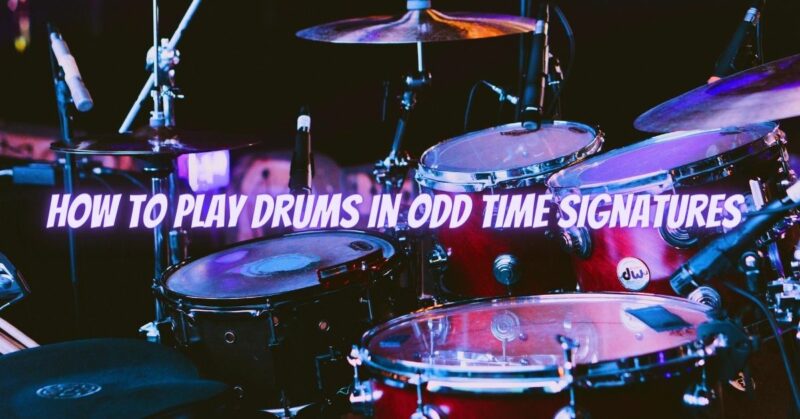Playing drums in odd time signatures can be both challenging and exciting. Odd time signatures, such as 5/4, 7/8, or 9/8, offer unique rhythmic possibilities that can add complexity and interest to your drumming. In this article, we will explore essential techniques and strategies to help you confidently navigate and play drums in odd time signatures.
- Understand Time Signatures: Familiarize yourself with the concept of time signatures and how they are represented in sheet music. Time signatures consist of two numbers: the top number indicates the number of beats per measure, while the bottom number represents the note value that receives one beat. For example, in 5/4 time, there are five beats per measure, and the quarter note receives one beat.
- Internalize the Pulse: Internalize the pulse or feel of the odd time signature by counting and feeling the subdivisions. Break down the time signature into smaller rhythmic units and count or tap along to establish a solid sense of the groove. For example, in 5/4 time, you can count “1-2-3-4-5” or “1-and-2-and-3.”
- Start with Simple Patterns: Begin by practicing simple patterns in the odd time signature. Start with a basic groove using the primary beats of the time signature, emphasizing the downbeat or strong beats. For instance, in 7/8 time, play a pattern accenting beats 1, 3, and 5, while filling in the remaining beats with lighter ghost notes or simpler rhythms.
- Break Down the Subdivisions: Break down the odd time signature into its rhythmic subdivisions. Experiment with different subdivisions, such as eighth notes, triplets, or sixteenth notes, within the given time signature. Practice playing rhythmic patterns using these subdivisions to create interesting and varied rhythms.
- Explore Accent Patterns: Experiment with different accent patterns to create rhythmic interest within the odd time signature. Play accents on different beats or subdivisions to create syncopation and polyrhythmic effects. Focus on maintaining a steady pulse while accenting specific notes or beats to add complexity and groove to your playing.
- Practice Metronome Exercises: Utilize a metronome or a drum machine to practice playing in odd time signatures. Start with a slow tempo and gradually increase the speed as you become more comfortable. The metronome will help you maintain a consistent pulse and develop a solid sense of timing in the odd meter.
- Listen to Music in Odd Time Signatures: Immerse yourself in music that features odd time signatures. Listen to artists and bands known for their use of odd meters, such as Dave Brubeck, Tool, or Rush. Pay attention to how they navigate and groove within these time signatures, and try to incorporate elements from their playing into your own drumming.
- Explore Polyrhythms: Delve into the world of polyrhythms by combining different rhythmic patterns and subdivisions. Experiment with playing different time signatures simultaneously, such as playing a 3/4 pattern with your left hand while maintaining a 4/4 pattern with your right hand and feet. This exercise helps develop coordination and expands your rhythmic vocabulary.
- Improvise and Experiment: Allow yourself to experiment and improvise within the odd time signatures. Take the time to explore different rhythmic ideas, fills, and variations while maintaining the groove. Use your creativity to develop unique drumming patterns and rhythmic phrases that showcase the beauty and complexity of odd meters.
- Practice, Practice, Practice: Consistent practice is key to mastering odd time signatures. Set aside dedicated practice time to focus on playing in odd meters. Start with slower tempos and gradually increase the speed as you become more proficient. Over time, you will develop a natural feel for odd time signatures and confidently incorporate them into your drumming repertoire.
Conclusion: Playing drums in odd time signatures requires patience, practice, and a solid understanding of rhythmic concepts. By understanding time signatures, internalizing the pulse, starting with simple patterns, breaking down subdivisions, exploring accent patterns, practicing with a metronome, listening to music in odd meters, exploring polyrhythms, improvising, and dedicating consistent practice time, you can develop the skills and confidence needed to play drums in odd time signatures. Embrace the challenge and enjoy the rhythmic possibilities that odd meters offer, as they can elevate your drumming to new levels of creativity and musicality.


